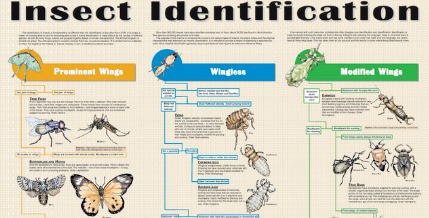I earn commissions if you shop through the links below at no additional cost to you.
Last Updated on April 22, 2023 by Jeremy
Have you ever been sitting around on your patio, enjoying the nature filled evening just staring at the dusk sky of flying insects? They can be a fascinating and vital part of our environment, playing roles in pollination, decomposition, and even as a food source for other animals, like the night bat.
But then there are those nasty insects which are known as pests, which cause harm to crops, livestock, and us as humans. This is why identifying the different types of flying insects can be critical for both pest control and environmental management.
Despite their importance, and within today’s article, we will learn about flying insect identification via how to identify them even though we are not entomologists. As challenging as it may be, I’ll explain it to the best of my abilities while mentioning the resources you have available to help with figuring out what these potential pests actually are.
Common types of flying insects
Without hesitation, here are some of the most common types of flying insects that you may encounter, or have encountered at one point in time:
Mosquitoes – Mosquitoes are known for their itchy bites and can carry diseases like West Nile virus, malaria, and dengue fever. They are attracted to standing water and feed on nectar and plant juices. We all know them as the number 1 pest in our lives, so let’s leave it at number one on this list.
If you can think of one good thing about mosquitoes, I encourage you to leave a comment below and I’ll be sure to add it as part of this article, but for the most part, let’s call these insects pests through and through.
Bees – Bees on the other hand are a different story, and play a crucial role in pollinating plants, and some species also produce honey. They can be identified by their hairy bodies and wings that fold longitudinally when not in use, not to be mistaken as a wasp.
The best part about bees is that they go beyond the pollination of plants, they even pollinate trees which you can read about in this article here: Do Bees Pollinate Trees? – 1 curious bee!
Wasps – Wasps are often mistaken for bees, like mentioned above, but can be distinguished by their slender bodies and narrow waist. They are predators and feed on other insects, but some species can also be pollinators.
To ultimately tell the difference between the two, I’ve located this lovely imagery that showcases all there is to know about bees and wasps:

Butterflies – Butterflies are known for their beautiful colors and patterns, and they play an essential role in pollination. They can be identified by their large, colorful wings and long antennae.
The most common of the butterflies you may know as the Monarch butterflies known for its memorizing colors of black and orange.
Moths – Moths, which are not butterflies but are still often mistaken for them, can be distinguished by their thicker, fuzzier bodies and more muted, grey-like colors. They are typically nocturnal and are attracted to light.
For you dad’s out there, here’s one of my favorite dad jokes:
How can you tell when a Moth farts?
It flies straight for a little bit.

Flies – Flies can be identified by their large beady, buggy eyes and a pair of wings. Without their wings they’d be called “walks”. Some species, like the fruit fly, are attracted to decaying organic matter, while others, like the horsefly, feed on blood, and well, horses. They can leave a nasty bite too.
A fly’s best friend usually 98% of the time is a fly-swatter and you can find them in your local hardware store or next to the sports section of your Sunday paper.
Dragonflies – Dragonflies are predatory insects that feed on other insects like mosquitoes and flies. They have large, transparent wings and long, slender bodies. As ugly as they may seem, they’re rather harmless and love going along for boat rides.

Grasshoppers – Grasshoppers have long hind legs that allow them to jump great distances, and usually into a moving vehicle in the summer time with the windows down on a grid road if not careful.
They are herbivores and feed on grasses and other plants. You can find them mostly in crops amongst the crickets, or sometimes at the end of a fishing hook.
Ants – Ants are social insects that live in large colonies. Known to lift 10 times their weight, they can be identified by their narrow waists and elbowed antennae.
There are apparently over 12,000 species of ants and can get as big as 2″, which is enormous if you’ve ever seen this video clip:
Beetles – Beetles are the largest group of insects (not the band), with over 400,000 species, more than ants. They have hard, protective wing covers and feed on a variety of things, from plants to other insects.
Some more well-known beetles you may know are the dung-beetle, and the ladybug. Each very distinctive of their own species.
Cicadas – Cicadas are known for their loud, buzzing calls. They have large, membranous wings and feed on tree sap. According to Wikipedia, it’s lifespan can get up to 17 years, which is rather long for some insects.
Cockroaches – Let’s be honest and call these pests right? Well, they do play important roles in decomposition and can even be used as a food source in some cultures. No thanks, I’ll stick to steak and potatoes any day.
Cockroaches can usually be identified by their flattened bodies and long antennae, but most definitely can be found dead when exterminated properly.
Termites – Speaking of exterminations, termites are social insects that feed on wood and can cause significant damage to buildings and other structures. They can be identified by their straight antennae and white or light-colored bodies.
If observed, they can be rather fascinating to watch them destroy wooden furniture, but the damages are usually costly, and they take forever to make a real amount of sawdust.

Ticks – Ticks are blood-sucking parasites that can transmit diseases like Lyme disease and Rocky Mountain spotted fever. They can be identified by their small, oval bodies and eight legs.
If you want to find a tick quite quickly, roam around in tall grass and/or trees with your canine friend for an hour or so in May-June, and you’ll be certain to count above the 10s in Saskatchewan.
Fleas – Fleas are small, and also blood-sucking parasites that infest pets and can also bite humans. They can be identified by their flattened bodies and long legs that allow them to jump long distances. Let’s not mistaken these critters for ticks, but we should treat them ideally the same.

How to identify flying insects
Now that we have discussed the most common types of flying insects, let’s discuss how to identify them.
One of the essential features to look for when identifying flying insects is wing shape. For example, butterflies have large, colorful wings, while mosquitoes have narrow, pointed wings. Body color and pattern can also be helpful in identifying insects. For example, ladybugs have bright red bodies with black spots, while beetles come in a variety of colors and patterns.
Antennae length can also be helpful in identifying insects. For example, bees have long, thin antennae, while mosquitoes have short, feathery antennae. Using a magnifying glass or binoculars can help you get a closer look at these features.
It’s important to note that some insects can look very similar to each other, so it’s essential to pay attention to the details. For example, wasps and bees can look very similar, but wasps have a more slender body and a narrow waist, while bees have a rounder body and a broader waist.
Remember to reference the imagery above for more information!
Resources for identifying flying insects
There are many resources available to help with identifying flying insects, including field guides, websites, and apps.
Field guides are books that contain detailed information and pictures of different species of insects. They are often organized by type or region and can be useful for identifying insects in the field. Some popular field guides for insects include:
- “National Audubon Society Field Guide to Insects and Spiders”
- “Kaufman Field Guide to Insects of North America.”
Websites like BugGuide.net and iNaturalist.org can also be helpful for identifying insects. These websites allow users to upload pictures of insects, and other users can help identify them.
There are also several apps available for identifying insects, two that come to mind are:
- “iNaturalist”
- “Picture Insect”
These apps use image recognition software to identify insects based on pictures you take with your phone’s camera.
~ As an Amazon Associate, I earn from qualifying purchases ~
Another alternative if you want the visual aid like ourselves is to obtain one of these posters from Amazon. They give quite the unique perspective as to what’s out there, and now!
Conclusion
Identifying flying insects can be both challenging and rewarding. By knowing the different types of insects, we can better manage pests, protect our environment, and appreciate the incredible diversity of the natural world.
Remember – pay attention to key features like wing shape, body color, and antennae length when identifying insects, and don’t hesitate to seek help from experts or use resources like field guides, websites, apps, or the suggested wall art chart linked above.
If you found this article helpful, please feel free to drop a comment below. Should you have any insects you’d like to mention, also add them into the comments box, as I feel of the millions of insects we have available, we should be able to identify a bunch with the aid of each other.
Earth is Heart!







Wow, really interesting article and although insects are rather pesky in most instances, they are all needed to balance out our eco system. I had no idea that there were three different varieties of bees. I always thought a bee was a bumblebee. Do they all die after losing their sting? The grass hopper and locust is my favorite insect and as kids we used to collect them, but they too can be detrimental in large numbers to farmers and our crop supply.
Thank you, Michel Maling, for your engaging comment!
I’m glad you found the article on flying insect identification interesting. You’re absolutely right that insects play a crucial role in balancing our ecosystem, despite some of them being pesky at times. It’s fascinating to learn about the diverse varieties of bees, and I’m glad the article shed light on the different types. Regarding your question about bees losing their sting, it varies among different bee species. Honeybees, for example, have barbed stingers that get stuck in the skin upon stinging, causing them to die after stinging. However, not all bee species have this type of stinger, and some bees can sting multiple times without harming themselves.
I share your fondness for grasshoppers and locusts. They can be captivating creatures, especially during our childhood adventures. However, you’re right that in large numbers, they can pose challenges for farmers and crop supplies. It’s a delicate balance to maintain the ecological harmony while ensuring the well-being of our agricultural systems.
Thank you for sharing your thoughts and personal experiences with these insects. It’s always fascinating to hear different perspectives and connections to the natural world.
Warm regards,
Jeremy